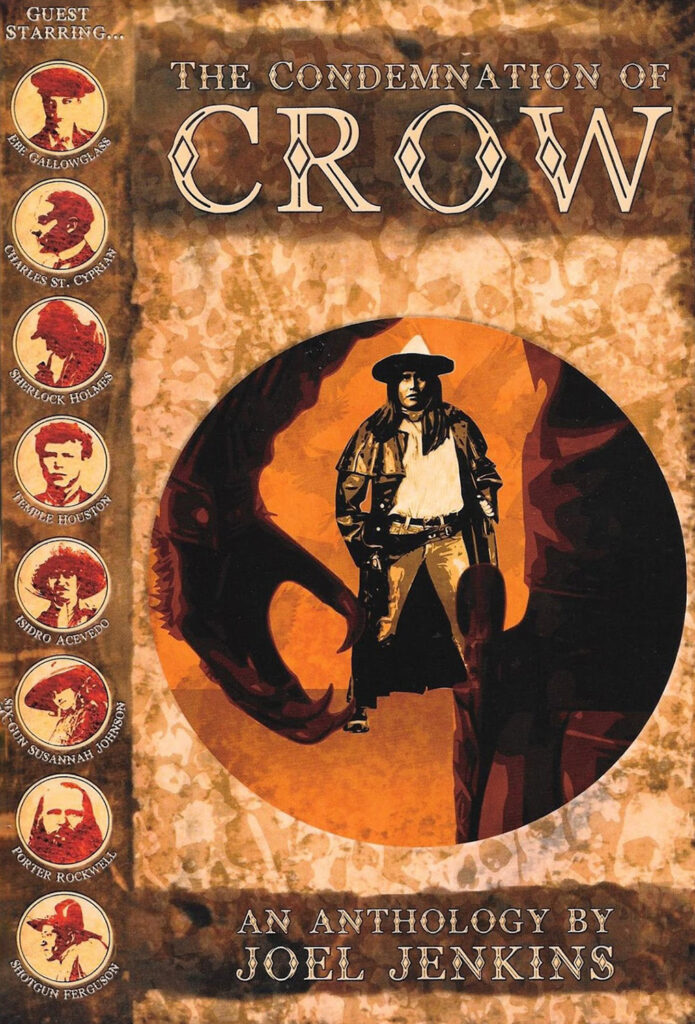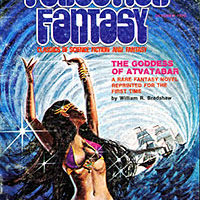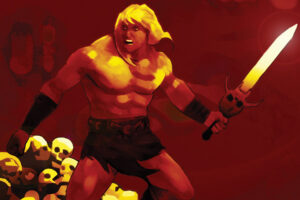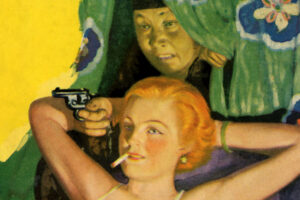 Lone Crow is a Native American shaman and gunfighter and an occult detective , set in the Old West, though some of his stories take him to other locations. This is the second of four volumes from PulpWork Press.
Lone Crow is a Native American shaman and gunfighter and an occult detective , set in the Old West, though some of his stories take him to other locations. This is the second of four volumes from PulpWork Press.
What we know of Lone Crow is that he’s the last of his tribe, and he was raised by a white couple in Colorado. He carries a Colt Peacemaker that was blessed by a prophet, which causes the bullets it fires to destroy evil. He is a bounty hunter, even tracking down Butch Cassidy and the Sundance Kid and their gang, as well as working for Miskatonic University. The occult threats he faces are very Lovecraftian, though often original, as well as some based on other traditions.
The Condemnation of Crow has 10 stories, seven of which appeared elsewhere. These stories vary in length from a couple of short vignettes to the title story, a novella(?) that takes up almost half the volume. The time setting of these stories isn’t clear, but they range from immediately after the end of the Civil War to 1925, when Crow has already passed away (?). So some stories are set in between stories from the previous volume. And many of the secondary characters from the previous volume show up as well. One story, by the way, was not written by Jenkins.
First up, we find Crow in New Orleans at the end of the Civil War, during which he had been working as a tracker. There he winds up meeting a young girl he immediately gets smitten with, and a rival suitor, Mexican gunslinger Isidro Acevedo. They wind up getting into a duel with swords in a graveyard — and dealing with ghouls, here called wyrds. We will also learn how Crow got his distinctive Peacemaker pistol, though at this point it’s not yet blessed.
In “The Vorpal Tomahawk,” Crow encounters a pair of well-known characters: Sherlock Holmes and Dr. Watson. Holmes wants to take Crow in for murder of an English Lord. Crow, however, had good reason to do so, which Holmes doesn’t understand. Even when confronted with evidence of why it was necessary.
Six-Gun Susannah Johnson is with Crow in the next tale, which is set shortly after their adventure dealing with the Hennesy Brothers in the previous volume. This time they are teamed up again to go after a bad guy, a Spider Crawford who has a past history with Johnson. Will they succeed?
In our next story, we find Crow now in his 50s and settled down in the hills outside of Salt Lake City with a wife (his second at least), who is expecting. (This story is set after the last story in the first volume.) A city councilman comes to ask him for help in a bizarre murder. A man was killed in a summoning circle, most likely by a demon he summoned. And a cache of occult books is found in his place. Interestingly, two are volumes that Crow had found for Miskatonic University. Will Crow be able to find who (or what) killed the man before others share his fate? BTW, it’s clear this story is set after most of the others here.
Shotgun Ferguson is teamed up with Crow, bringing in a cash box owned by a railroad when they are ambushed by a group of bad guys. And they make the mistake of going into a grove known as Satan’s Hollow during a storm. What will they find and can they get out safely?
Next up, we get both Six-Gun Johnson and Isidro Acevedo with Crow. They are after some bad guys who also grabbed a couple of girls. But things are complicated when a meteor lands nearby and brings something with it. Two somethings! Who will get out unscathed?
The following story is set in 1925 and was written by Josh Reynolds, and stars his occult detective Charles St. Cyprian, the Royal Occultist, and his assistant Eve Gallowglass, whom I’ve posted on before. Crow doesn’t appear here (he is dead), but the story does concern him. The two contend with an Old West outlaw who is now something more.
The final piece is the title story, “The Condemnation of Crow.” Crow is in Dodge City on trial for killing two men in what is clearly justified. He is being defended by Temple Houston, a real person who was a son of Sam Houston. Also around is Wyatt Earp, who is a town marshal. After being found guilty, Crow is ordered by the judge to help locate a missing stagecoach that has a shipment of whiskey, some girls who will be working in one of his brothels, and the judge’s niece. In exchange, Crow can go free.
Crow, Temple, Earp, and another head out. They find that a strange shaman, the last of an ancient and sinister race, is the one behind it. He has various powers and can call up things. He plans on rebuilding his race, taking the girls as his wives. The men are able to rescue the girls, at least the niece and one other. But this won’t be the end of it, as the shaman still lives. And there are some unanswered questions, like where and how he learned English, and why he has only been attacking stagecoaches and not the train.
Some of what is in these stories doesn’t make much sense, time-wise. I’m not sure about the timing of this last story. Earp was in Dodge in the 1870s, leaving in 1879. But Temple didn’t get his law degree until the 1880s. And mention is made of Butch Cassidy, who didn’t become active until much later.
I would like to see some kind of timeline for the stories, but that’s just me.
Each of the four volumes have the same cover design style, which I like. However, with my copy of volume 1 the cover had a matte finish (think that’s the right term), which fit well with the design. But this one had a smooth, glossy finish which clashes with the first one. I wonder what we’ll get with the next two volumes, which I plan on getting at some point?
Again, it’s a great collection. If you like weird-western stories or occult detectives, this is a series to check out.



